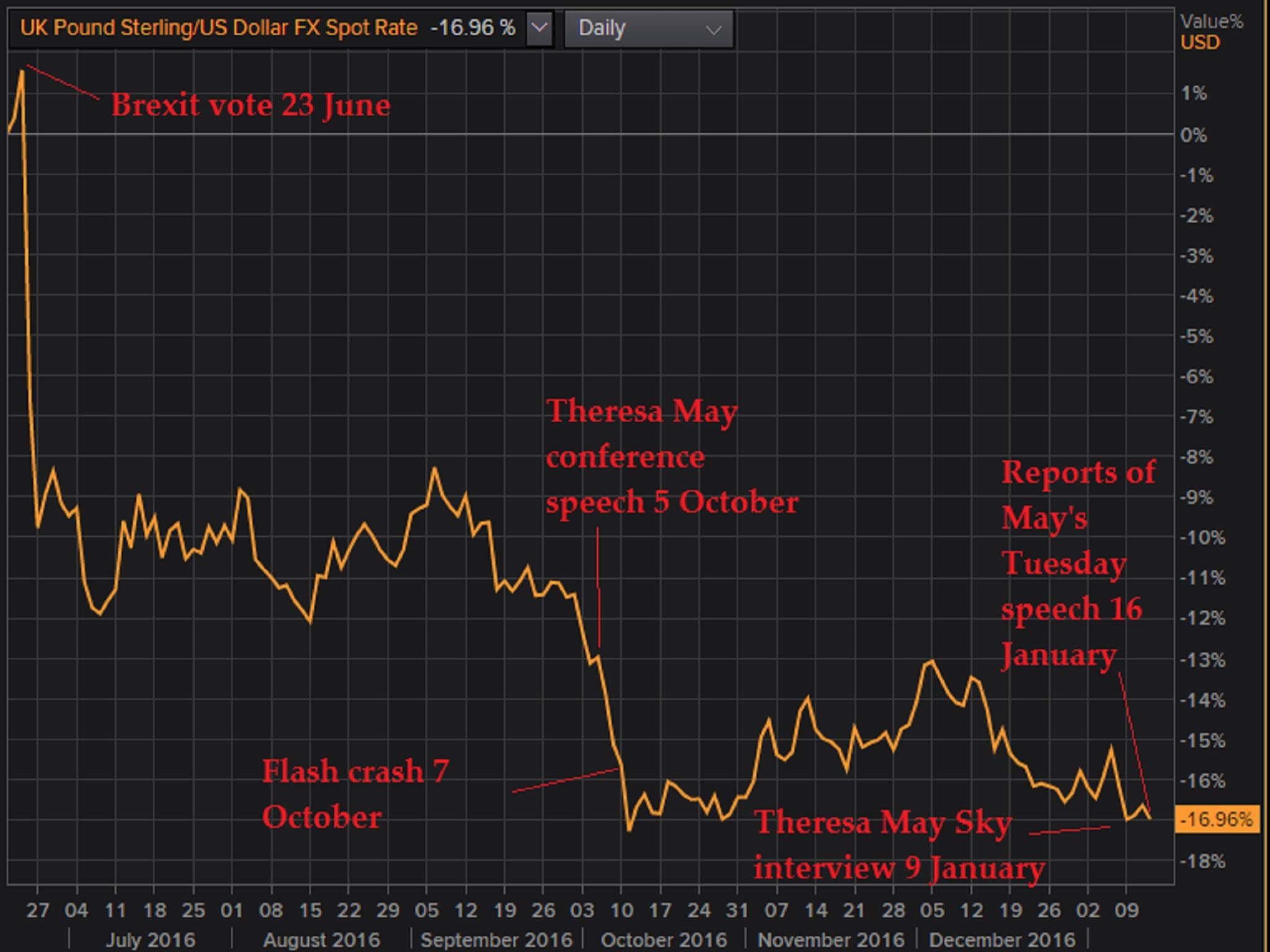Pound sterling slump: The key moments in six charts – and how low it could drop
Most economists expect the pressure on the pound to get worse, increasing the volatility across the broader market

The pound slumped to a fresh 31-year low on Monday with investors again concerned by media reports that the Government is preparing for a hard Brexit from the EU.
The currency has fallen about 19 per cent against the dollar since the UK voted to leave the EU in June’s referendum, with declines since the initial aftermath of the vote mainly sparked by concerns that Prime Minister Theresa May plans to quit the EU’s single market in order to regain control of Britain’s borders and laws.
With less than three months to go until Ms May’s own deadline for triggering formal talks with Brussels, details of the UK’s exit strategy remain scant. Nonetheless, traders appear ready to sell the pound at any opportunity.
So what were the key moments for the pound since 23 June? And what will happen once Article 50 is triggered?
The morning after (Friday 24 June)
Confirmation that the UK voted to leave the EU sent sterling down $1.33, depths it has not been plunged since 1985.
Ms May sets Brexit start date (4 October)
The pound hit yet another 31-year low against the dollar in October.
Mrs May told the Conservative Party conference on 2 October that Britain would trigger Article 50, the official legal notification that would formally begin negotiations with the remaining EU powers, “no later than the end of March”. That set the UK up to leave the bloc by 2019.
Sterling dropped to $1.2764 in early trading on that day extending losses suffered on the previous day.
Ms May’s speech left investors specifically worrying about two big issues: British exporters may find it harder to compete in Europe; and the country's banks could lose the ability to do business freely across the region.
Sterling fell further that week as Chancellor Philip Hammond flew to New York in a bid to reassure UK banks after the Brexit vote.
The pound dropped below the $1.27 mark against the dollar, down to just $1.2632.
A mysterious flash crash (7 October)
The pound suffered a sudden collapse hitting yet another 31-year low against the dollar in mysterious circumstances, sparking market chaos in “insane” early trading. This drop was sterling’s biggest since Britain voted to leave the EU in June.
Overnight, sterling plunged about 6 per cent to $1.1841 in just two minutes before recovering to $1.24 against the dollar.
In a much-anticipated report, the Bank for International Settlements (BIS) last week concluded that the crash was not a unique or unprecedented event but “a new data point in what appears to be a series of flash crash events occurring in a broader range of fast electronic markets than was previously the case in the post-crisis era”.
It also warned that such events “have the potential to undermine confidence in financial markets and hence impact the real economy.”
Some (temporary) legal respite (3 November)
The pound surged to a four-week high against the dollar and euro after a High Court ruling that only Parliament could start the process of leaving the EU raised hopes of a “soft Brexit”.
Sterling rose by 1 per cent against the dollar trading above $1.24 in the immediate aftermath of the ruling.
The High Court ruling meant that the Government could not begin formal negotiations to leave the EU without a vote in Parliament. It also offered hope to markets that Mrs May, would be forced to pursue a “soft Brexit”.
Ms May's New Year warning (9 January)
The pound came under renewed pressure after Mrs May said Britain will not attempt to cling on to a “bit of EU membership” in her New Year TV interview.
Sterling was down by more than 1 cent at below $1.22 in late trading on that Monday.
More pre-May jitters (16 January)
The pound's latest fall comes ahead of a of a key speech by Ms May on Tuesday, in which she is expected to spell out Britain’s negotiating strategy for Brexit talks.
Investors fear that she will indicate the UK will leave the single market and the customs union, effectively spelling a hard Brexit.
That has combined to send the pound to a yet another 31-year low (excluding that flash crash in October).
Sterling fell against all of its major peers, dropping below $1.1985 against the dollar in early Asian trade on Monday, before recovering slightly to just above $1.20 at market closing time.
What happens next? Parity on the horizon
Most economists expect the pressure on the pound to get worse, increasing the volatility across the broader market.
The pound is likely to drop around 5 per cent to $1.15 against the dollar after Ms May triggers Article 50, according to a Reuters poll of more than 60 foreign exchange strategists.
Some forecasters said the pound may reach, or even fall below, parity with the dollar. This is the first time anyone has made that forecast in more than 20 years of Reuters polls on the currency.
On Monday, analysts at Unicredit said: “[We] believe that sterling is a sell on any potential rallies. Even in the event of a more “conciliatory” tone – by Theresa May hinting at seeking out a transitional agreement with the European Union, for instance – the respite on sterling is very likely to be only temporary.”
Subscribe to Independent Premium to bookmark this article
Want to bookmark your favourite articles and stories to read or reference later? Start your Independent Premium subscription today.

Join our commenting forum
Join thought-provoking conversations, follow other Independent readers and see their replies